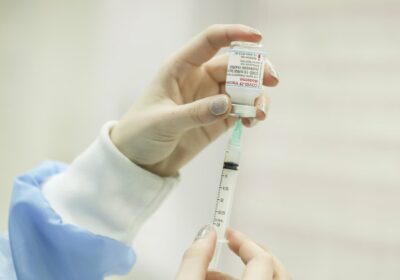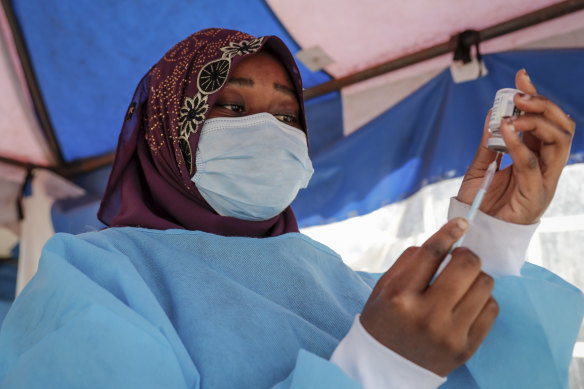Free COVID jabs for young people might not be good policy any more. Here’s why

Examine, a free weekly newsletter covering science with a sceptical, evidence-based eye, is sent every Tuesday. You’re reading an excerpt – sign up to get the whole newsletter in your inbox.
A few weeks ago, I had my latest COVID-19 booster. And let me tell you, I felt very virtuous.
At 32, I’m lucky enough to be considered “young and healthy”, and I’d already had four shots. I knew I wasn’t at risk of severe illness, but I was doing my part, I thought, to stop spreading the virus to other more vulnerable people, just as we’d all been asked to do throughout the pandemic.
I was doing the right thing.
Or so I thought.
Conversations with leading vaccine scientists in the weeks since have left me wondering if I got that call right.
“We’re probably just not going to get the sort of coverage we would need to make an effect on transmission any more,” Professor Allen Cheng, director of infectious diseases at Monash Health, tells me.
Allen Cheng, pictured when he was Victoria’s deputy chief health officer in 2021.Credit:Joe Armao
Scientists are actually a step ahead in this debate: they are discussing whether the government should be subsidising the vaccine for young people at all.
“It’s a good question, and one we need to ask. I know people are thinking about this,” Cheng says.
“It’s a very different situation to where we were.”
No kidding, Allen!
In this week’s Examine, we ask – should young, healthy people be getting the latest booster?
Risk
Let’s start with the risk that COVID-19 poses to young, healthy people who have had at least two doses of vaccine.
The relationship between age and risk of death from COVID-19 is strong. At age 35, 0.1 per cent of unvaccinated people who catch the virus will die from it; this rises to 1 per cent by age 60 and 8 per cent by age 80.
That means this older group accrues much more value from a vaccine or booster. Israeli data suggests a bivalent booster cuts hospitalisation rates by 81 per cent in over-75s, and probably cuts mortality by the same amount.
A nurse prepares to administer an AstraZeneca vaccination against COVID-19 at a district health centre in Nairobi, Kenya.Credit:AP
It’s reasonably difficult to measure the protection against severe illness a fourth or fifth booster might provide a young, healthy person. Because the proportion of young, healthy people who get severe disease is small, the studies needed to elucidate it would need to be large, says Dr Claire von Mollendorf, who is part of a trial on fourth doses at the Murdoch Children’s Research Institute.
The UK has produced handy modelling looking at “number needed to vaccinate”: how many people would you need to vaccinate to prevent one person being hospitalised?
For the first two doses, you’d need to vaccinate 21,700 healthy people aged 30 to 39 (this is with Omicron, so against earlier strains the number would have been lower).
“One or two doses was huge bang for your buck,” says Cheng.
For a fourth dose, you’d need to vaccinate 210,400 people. Not so much bang for your buck.
What about severe hospitalisation? If you’re aged 35 and healthy, giving a fourth booster to everyone would prevent “no cases”. None!
To this, we can add the reality that most of us now have hybrid immunity thanks to a breakthrough infection. Evidence suggests hybrid immunity is even stronger than vaccine-induced immunity – there is 97.4 per cent effectiveness against preventing severe disease 12 months after infection.
The figures are similar for people who have hybrid immunity plus a booster – suggesting, again, there isn’t a huge amount to be gained.
Transmission
The big reason I and many other people my age had a COVID-19 vaccine was to try to slow transmission of the virus through the community, take the load off the healthcare system and protect the vulnerable.
We may have reached a point where the vaccines are no longer achieving any of those goals.
There is high-quality evidence that getting a booster reduces transmission. Sophia Tan and colleagues tracked infections at 35 California state prisons and found infected, unvaccinated cases had a 36 per cent chance of passing on Omicron – compared to 28 per cent in a fully vaccinated inmate.
SARS-CoV-2 virus particles which cause COVID-19.Credit:AP
Each dose of vaccine, up to three, reduced transmission by about 11 per cent, in relative terms. The true transmission reduction value will be higher as a person who is vaccinated is less likely to get infected, and therefore less likely to pass the bug on.
But that’s not the full picture. Booster rates are low (45 per cent for fourth doses) particularly among the young people who do most of the transmitting. Under-30s only just became eligible for a fourth dose, so we can guess their rates are even lower.
“To reduce transmission on a population level, you need really high population coverage,” says von Mollendorf.
Getting a booster to reduce transmission, when a) no one else is getting one and b) it provides only partial protection, seems equivalent to trying to plug a waterfall with a finger. Federal government modelling suggests the transmission-suppressing effect of vaccination has fallen to just 12 per cent.
In new guidance released last week, the World Health Organisation’s Strategic Advisory Group of Experts on Immunisation said it would not recommend additional boosters (i.e. beyond a third dose) for healthy people aged under 60 “given the comparatively low public health returns”.
Long COVID
One possible reason a young person could want a booster: a reduction in the risk of long COVID.
There’s lots of evidence people who are unvaccinated are more likely to have long-lasting COVID symptoms, but we don’t know about the effect of boosters.
On the other hand, you could be persuaded by (very) controversial evidence suggesting each subsequent reinfection seems to increase harms to a person. If that holds up, doing everything you can to avoid reinfection makes sense.
“The evidence probably isn’t there to say it’s a good reason to do it, but it might fit into some people’s strategy,” says Cheng. “It’s rational – but the evidence isn’t necessarily strong.”
Actually, cost-effectiveness does matter
You might be thinking to yourself, “well, does it really matter? If people want a vaccine, let’s just pay for it.”
But the health dollar is finite. Professor Peter McIntyre, a leading vaccine expert at the WHO, suggests a good comparator: the meningococcal B vaccine. Health authorities have repeatedly refused to fund it – despite modelling showing that rolling it out to Australia’s children would prevent nine deaths over five years and 93 children with lifelong injuries in that period.
At $400 million, that’s not deemed cost-effective.
The government just signed a deal with Moderna for a new supply of 3 million doses of COVID vaccine this year – but we have no indication how much that will cost (the US pays about USD$15 ($23) a dose).
It would seem the health dollar remains finite, except when it comes to COVID-19.
Enjoyed this article? The Examine newsletter explains and analyses science with a rigorous focus on the evidence. Sign up to get it each week.
Most Viewed in National
From our partners
Source: Read Full Article


